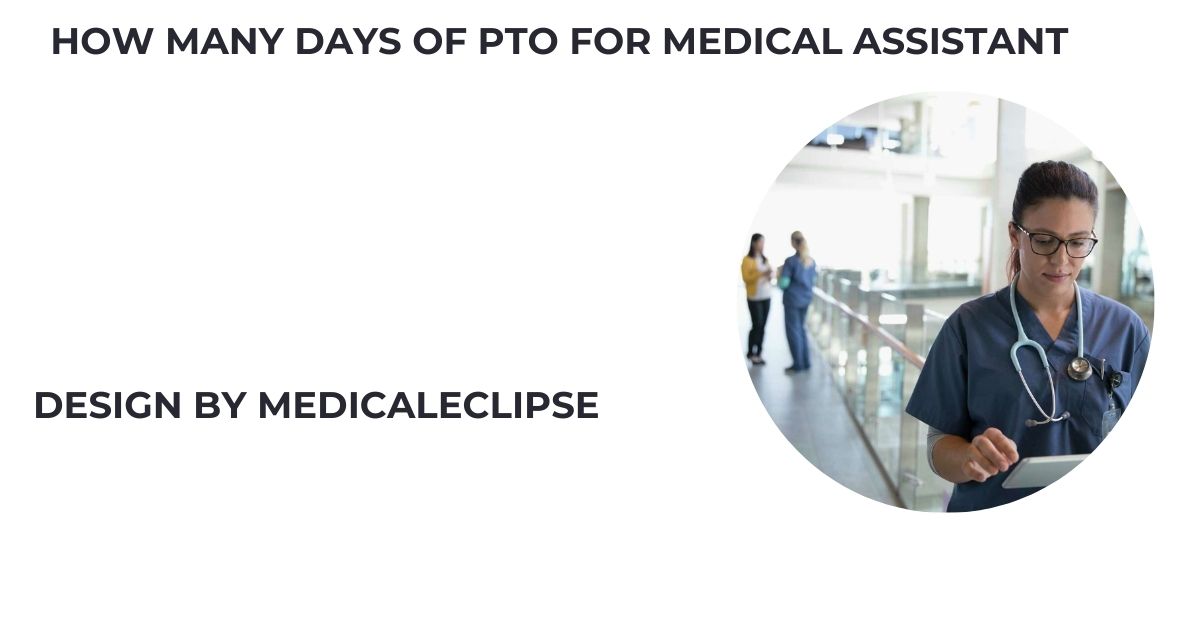Medical assistants typically receive 10 to 20 days of PTO per year, which can include vacation, sick leave, and personal days. The exact amount varies depending on factors like experience.
In this article, we’ll discuss how many days of PTO a medical assistant can expect and how to make the most of your time off.
What is PTO for Medical Assistants?

Paid Time Off (PTO) refers to the days that employees can take off from work while still receiving their regular pay. This can include vacation days, personal days, and sick leave. As a medical assistant, PTO benefits are offered by your employer and can vary depending on the type of practice or healthcare facility you work in.
How Much PTO Can a Medical Assistant Expect?
On average, medical assistants receive around 10 to 20 days of PTO per year. This can include both vacation days and sick days. The exact amount of PTO can depend on several factors, such as:
Average PTO for Medical Assistants:
On average, medical assistants can expect between 10 to 20 days of Paid Time Off (PTO) per year. This time off usually includes vacation days, personal days, and sick leave combined, although some employers might separate these categories.
Impact of Experience on PTO:
Medical assistants with more experience or those who have worked longer at a particular facility might receive additional PTO days as a benefit for their service. For example, someone with 5 or more years of experience could receive 15 or more days of PTO compared to a new hire who might only get 10 days.
Employer Type and PTO:
The type of employer plays a significant role in how much PTO is offered. Large healthcare organizations such as hospitals, medical centers, or government facilities often offer more generous PTO benefits than smaller private practices. Larger employers may also provide additional benefits like holiday pay or bonuses that increase the overall PTO package.
Full-Time vs. Part-Time:
Full-time medical assistants typically receive more PTO than their part-time counterparts. Full-time workers often accumulate PTO on a monthly or yearly basis, whereas part-time employees may accrue PTO at a slower rate or may not be eligible for as many PTO days, depending on the employer’s policy.
How PTO is Accrued?
PTO typically accrues over time. For example, a full-time medical assistant might earn 1 day of PTO per month, which would add up to 12 days per year. In some cases, PTO could be offered on an accrual basis starting with a certain number of days upon hiring, with additional days added after completing a specific number of months or years of service.
Also Read: Is The Medical Health Letter From Spainguru Legitimate – Scam or Legit!
How Does PTO Accrue?
PTO usually accrues over time, meaning you’ll earn a certain amount of PTO hours or days per month or year. For example, you might earn about 0.5 to 1 day of PTO per month of full-time work. Over the course of a year, that could add up to 12 or more days of PTO.
PTO Policies Vary by Location and Employer:
While these are general guidelines, it’s important to remember that each employer has their own policies regarding PTO. Healthcare settings such as hospitals or large medical centers may offer more generous PTO packages compared to smaller private practices. You’ll want to review your specific employer’s policy to see exactly how much PTO you’re eligible for.
How to Make the Most of Your PTO?

Making the most of your Paid Time Off (PTO) is important for maintaining a healthy work-life balance and ensuring you’re getting the time off you deserve. Here are some tips to help you maximize your PTO as a medical assistant:
Plan Ahead:
- Give ample notice: Try to request your PTO as early as possible. This gives your employer enough time to plan for your absence and makes it more likely that your request will be approved.
- Consider the workload: If your workplace has busy seasons, try to schedule your time off during slower periods to avoid disrupting operations. For example, you might avoid taking time off during flu season if you’re in a high-demand healthcare setting.
Combine PTO with Holidays:
- Maximize long weekends: If your employer gives you holidays off, consider using PTO to extend long weekends. For example, take a day or two off around a public holiday to get a longer break without using too many PTO days.
- Plan vacations around public holidays: Scheduling a vacation near holidays can help you stretch your PTO further, allowing you to take a longer break while using fewer days.
Use PTO for Self-Care:
- Recharge when needed: PTO isn’t just for vacations—use it to take a mental health day or to rest when you’re feeling overwhelmed. Taking time to recharge can help prevent burnout and keep you performing at your best when you return to work.
- Personal time: You can also use PTO for personal tasks like running errands, attending appointments, or spending quality time with loved ones, which helps improve your overall well-being.
Keep Track of Your PTO:
- Monitor your PTO balance: Regularly check how much PTO you’ve accumulated and make sure you’re using it before it expires. Some employers have a “use-it-or-lose-it” policy, so keeping track can help you avoid losing unused days.
Also Read: Do Military Medical Always Document In Your Paper Medical Records– Paper vs. Digital!
- Know your accrual rate: Understand how PTO is accrued at your workplace. If you earn a certain amount each month, plan your time off around that to make sure you’re using it efficiently.
Prioritize Time Off for Important Events:
- Request time for major life events: Whether it’s a vacation, family celebration, or important personal event, plan ahead and use your PTO for these moments. These breaks can make a big difference in your overall job satisfaction and quality of life.
FAQ’s
1. How much PTO do medical assistants get?
Medical assistants usually get 10 to 20 days of PTO per year, depending on their employer and experience.
2.Does PTO include sick leave for medical assistants?
Yes, PTO can include sick leave, vacation days, and personal time off, though some employers separate sick leave.
3.How does PTO accumulate for medical assistants?
PTO typically accrues over time, such as earning 0.5 to 1 day per month of full-time work.
4.Do part-time medical assistants get PTO?
Part-time medical assistants may get PTO, but usually fewer days than full-time employees.
5.Can medical assistants use PTO for personal reasons?
Yes, PTO can be used for personal reasons, including vacations, personal time, or sick leave, depending on the employer’s policy.
Conclusion
The amount of PTO you can expect as a medical assistant can vary, but on average, you’ll receive anywhere from 10 to 20 days per year. Be sure to check with your employer for specifics on their PTO policy, as it can differ depending on the location and type of facility. With the right planning and understanding, you can enjoy your time off and keep your work-life balance in check.

Leave a Reply